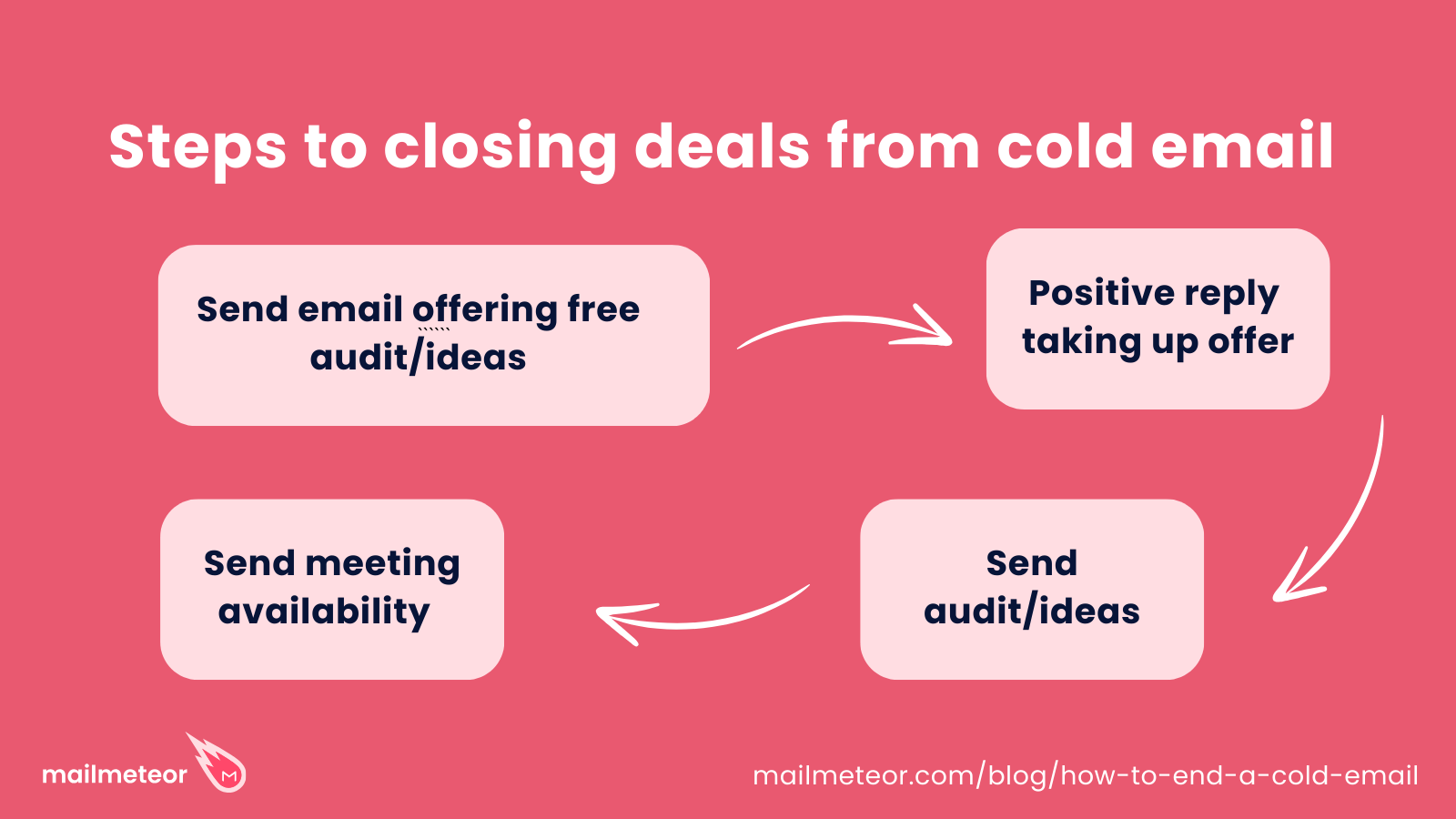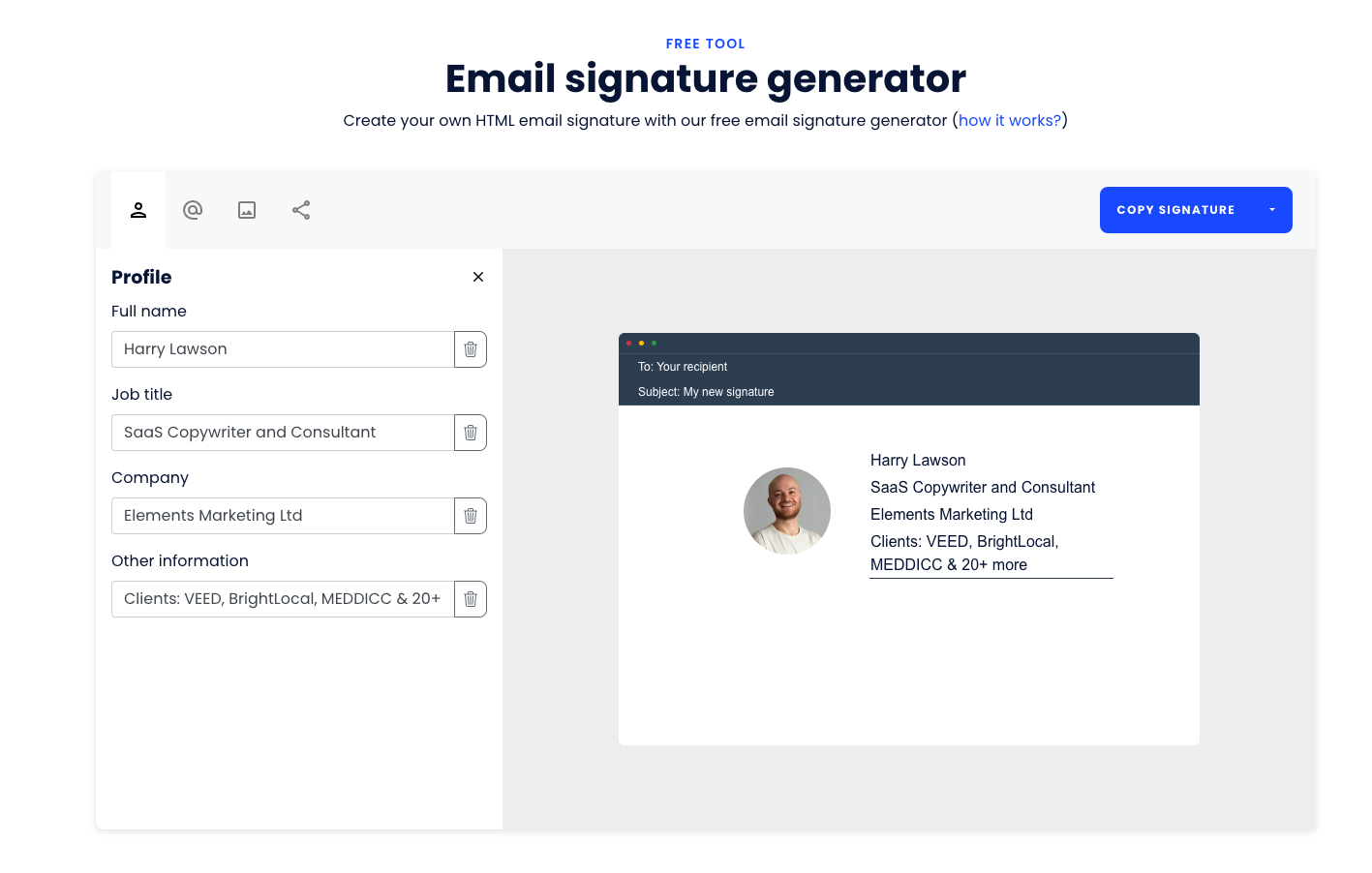Struggling to get a response from your cold emails?
You might be doing all the right things inside your cold emails:
- Creating a subject line that sparks curiosity about something your prospect cares about.
- Ensuring your value proposition is tied to solving their pain points.
- Personalizing the email to avoid sounding like part of a mass blast.
But one thing often overlooked is how you end cold emails.
Think about it: how you end your email directly impacts what your prospect will do next.
In this post, I’ll walk you through how to end a cold email effectively so you can win more business.
Let’s dive in.
What’s the Goal of Your Cold Email?
Before you even think about how to end your cold email, you need to clarify what exactly you’re offering and what you want your prospect to do next.
Nailing this down first will make it far easier to end your cold email.
And when it comes to getting a response you’ll improve your chances because your prospect will know exactly what you offer and how to respond.
Here’s an example ‘plan’ to use as inspiration for your campaigns:

3 Things to Consider When Ending Cold Emails
1. Make Your Call-to-Action Clear and Simple
Your CTA (call-to-action) will always depend on the objective of your campaign.
Whether it’s getting more information about your offer, scheduling a meeting, or taking you up on a free trial, the goal is to keep it clear and simple.
Remember: People don’t have the time to figure out what they’re supposed to do next. The easier you make it, the better the chance you’ll get a response.
Clear CTA examples:
Hey [name],
I love what you’re building at [Company]. I have been a customer of yours since [notable event]. I use my [product] every morning.
I help [Example] tools like [Client] with their [Your service]. I’d love to do something similar for you.
I’m curious to know if you’d be open to me sharing a few ways you could optimize your Instagram page for more sales?
Cheers,
[Name]
Hey [Name],
I was doing some research for a client and noticed you’re pumping out great content on Instagram. I loved the series you did in November on [product].
I have a couple of content ideas for [product]—mind if I share them with you?
Cheers,
[Name]
Takeaway: The simpler the ask, the more likely your prospect is to respond.
2. Avoid Asking for Too Much Too Soon
One of the biggest mistakes in cold emails is trying to sell a meeting or an entire product in a single message.
In reality, the goal of your first email is just to start a conversation and get a reply. Think of it like dating—you wouldn’t ask someone to book a 30-minute call in your first message, right?
You’d build rapport first.
Avoid making your ask too big in your first email. Most replies come when the recipient can respond in a few words, reducing friction.
Small ask example:
Hey [Name],
Is there any reason you aren’t posting content on LinkedIn right now?
– [Name]
Takeaway: Focus on small, low-effort asks to get the conversation started.
3. Prioritize Relationships Over Sales
By definition, a cold email means your recipient doesn’t know you, like you, or trust you yet. So, instead of diving into a hard sell, position your email as an opportunity to connect and build a relationship.
It’s more about: “Here’s who I am and what I do—does that align with your priorities?”
Relationship building example:
Hey [Name],
I’d love to connect and learn how [Company] came to be and how things are going.
I work exclusively with [companies like you] and always look to connect with others in the space.
It’s interesting that you’re focusing on demos to introduce your tools. I’m curious if you’ve thought about implementing [Idea]?
If this resonates, I’d love to chat over virtual coffee.
Cheers,
[Signature]
Takeaway: Build a relationship first. The sale will follow if there’s a good fit.
5 Things to Include at the End of Your Cold Email

1. Use a P.S. to Soften the Ask
As well as ending your cold email with a solid CTA, you can use a P.S. at the bottom to soften the ask.
This could be a compliment, showing that you’re paying attention, or even a plug for additional content or services that might be relevant.
Just make sure your P.S. fits the tone of the rest of the email.
P.S. Examples:
- P.S. Did you know I was the photographer for [Example] or [Example]?
- P.S. Loved your conversation with [Example] on the [Example] podcast.
- P.S. When you’re ready, here are a couple of ways I can help you:
- P.S. I just spoke about [topic relevant to them] on [podcast]. Have a listen here.
2. Create a Custom Email Signature for Cold Outreach
Your email signature gives you a solid way to add credibility to your cold email and adds another layer of social proof.
However, avoid using your everyday signature with a bunch of links to your socials and various webpages. This can overwhelm your prospect, give them too many distractions, and even harm your email deliverability.
That’s why I recommend creating a dedicated email signature specifically for cold outreach. It keeps things clean, focused, and professional. You can easily create your own email signature using Mailmeteor’s free email signature generator.

3. Propose a Time to Meet

Getting your prospect on a call is often the next step after your initial email. On a call, you can dive deeper into who you are and what you can offer.
Instead of asking, ‘when are you free to chat?’
Make it easy for them to book time by using scheduling apps like Calendly or another calendar tool to reduce the back-and-forth. Or anchor your ask with a specific option e.g. ‘Does Tuesday or Wednesday at 2pm work for you?’
This makes it easier to take the next step and shows you respect their time.
Meeting request example:
Would be great to jump on a call to discuss this further. Do any of these times work for you? [Insert calendar link]
Cheers,
[Name]
4. Offer an Opt-Out to Avoid Spam
The last thing you want when sending cold emails is to be marked as spam. It can permanently harm your email reputation, meaning future cold emails won’t even land in people’s inboxes.
To avoid this, always offer an opt-out option in your cold emails.
You could say something like:
P.S. If you don’t want me to contact you anymore, just reply to this email and let me know.
If you’re sending thousands of bulk emails, to comply with Gmail’s new anti-spam regulations, you should include an unsubscribe link at the bottom of your email to make it easy to opt out.
Tools like Mailmeteor make it easy to add an unsubscribe link to all your cold emails, ensuring compliance with these regulations and protecting your sender reputation.
5. Finish with an Open Question
Ending your cold email with an open question encourages your reader to think about your message and respond.
Open-ended questions are easier to reply to and can lead to a higher response rate, as they naturally invite engagement.
Recruitment example:
Hey [Name],
Is there any reason you wouldn’t be interested in a new role right now?
– [Name]
Key takeaways (and next steps)
How you end your cold emails directly impacts your chances of getting a response, and ultimately, the success of your outreach campaign. Whether you’re offering value, asking for minimal effort, or building relationships, the right closing can turn a cold email into a warm lead.
Here’s a quick recap:
- Clarify your goal and align your call to action with it.
- Keep your ask simple to reduce friction and improve response rates.
- Focus on building relationships before pushing a hard sell.
- Use tools like Mailmeteor to create professional signatures and add an unsubscribe link for compliance.
Now it’s time to apply these strategies to your own cold emails. Take a moment to review your current email closing tactics—are they clear, concise, and aligned with your goals?
Start optimizing today by implementing one of these tips in your next cold email campaign. And don’t forget to use tools like Mailmeteor to craft your cold email signature and manage scheduling links seamlessly.
FAQs
How should you end a cold email?
You should end a cold email with a clear call to action of what your prospect should do next. Avoid making your ask so big, you’re only trying to kickstart the conversation.
A good way to get a response is to offer something of value they can’t refuse, e.g., free ideas with no obligation.
What is a good closing sentence for an email?
An open question that is easy to say yes to without a time commitment on their end to start the conversation.
Why is the end of cold email important?
How you end your cold email directly impacts whether you’ll get a reply. If it’s unclear, or if you ask too much, you’ll see little to no response.


